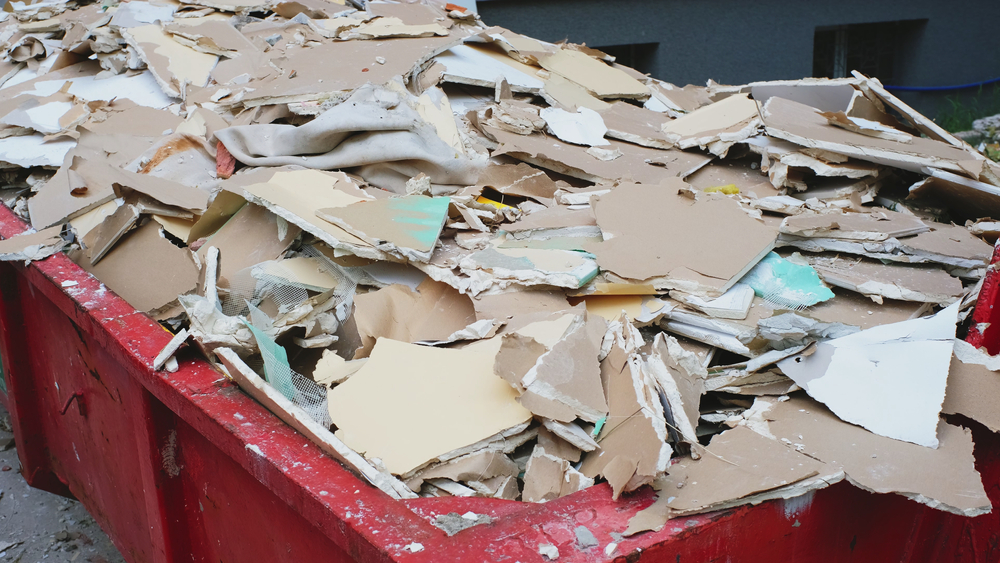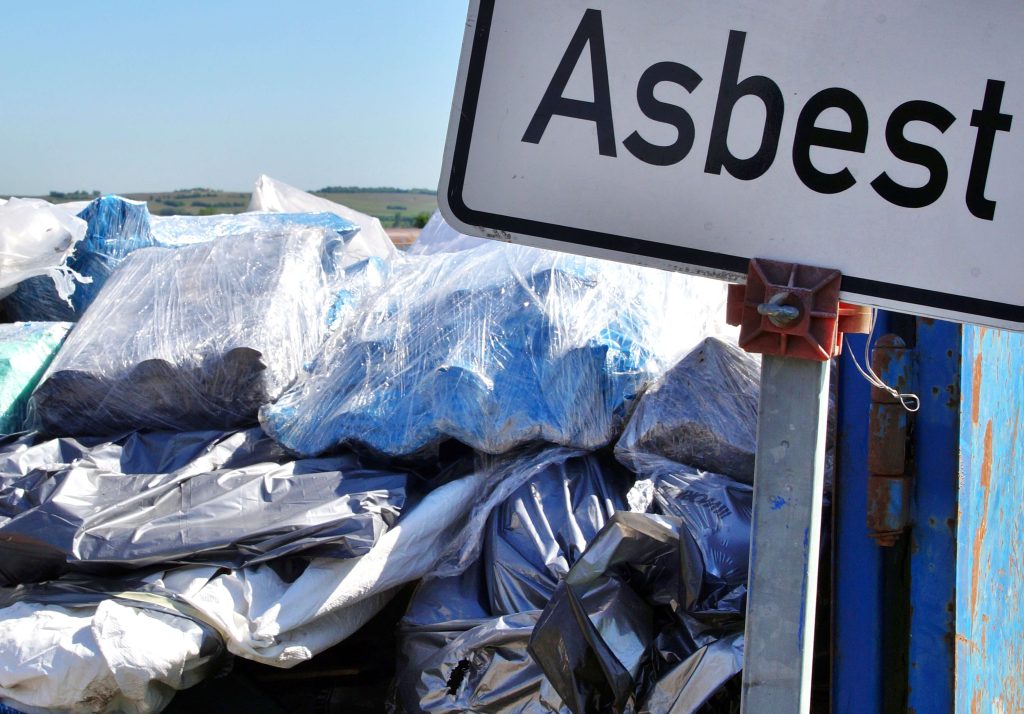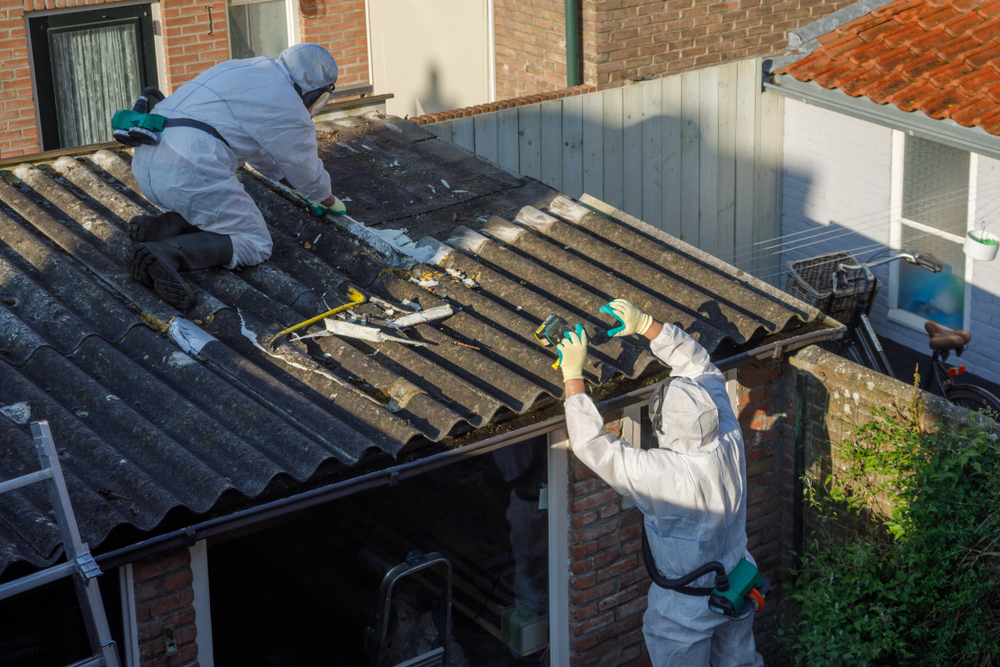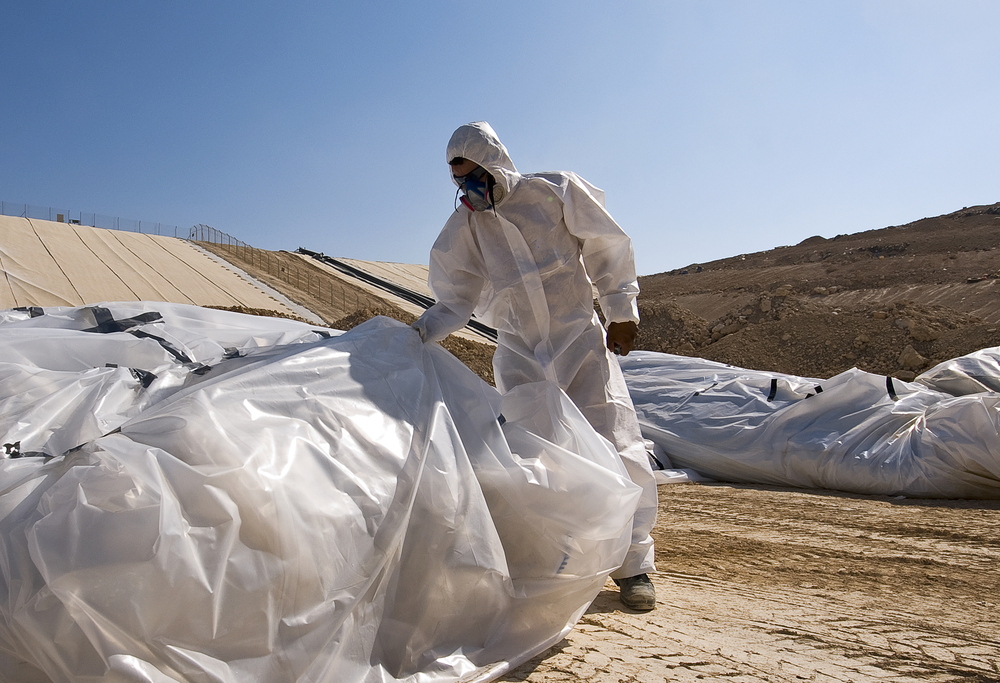
It’s vital to understand how best to handle and dispose of asbestos waste, as its fibres can cause severe health problems like lung cancer or mesothelioma.
This guide outlines the types of hazardous materials found in constructions built before 1988, such as this fibre, along with information on finding a licensed removalist team for safe handling and locating certified landfills that accept these items.
We’ll provide an overview into legal regulations related to disposal process safety measures you should take for your family’s protection. Allowing us access to a roadmap towards effectively managing any toxic substances present in our environment. So let’s get started by learning all about disposing of asbestos responsibly!

Asbestos waste is highly dangerous and can be found in many materials used before the 1980s. It may include insulation, roofing tiles, siding or flooring. If this hazardous material isn’t discarded properly, it could lead to serious health risks for humans. Different types of asbestos require different methods when disposing of them safely, while friable asbestos must have special precautions taken during disposal due to its easy crumbling nature.
Domestic and commercial are two main categories regarding these matters as they each necessitate their own distinct process. Accordingly, we will go into detail about both later on in the text. Lastly, correctly discarding materials containing asbestos remains a key action that should not be overlooked if one wants to protect people from potential harm brought by such substances.

Asbestos waste from residential properties may include tiles, scraps and dust that should be packed properly in double-bagged 0.2 mm thick polythene bags that are sealed securely.
The asbestos warning must also be clearly labelled on them. It is recommended to review local council guidelines for disposing of this kind of waste before proceeding.
Concerning commercial construction such as factories or warehouses, strict disposal strategies tend to be imposed due to larger quantities posing bigger health risks associated with it than domestic ones do.
The danger associated with asbestos waste demands the necessity of engaging certified professionals to ensure safety and regulatory adherence. Inhaling fibres can cause inflammation, scarring, and lung cancer or mesothelioma due to it being classified as a carcinogen. Even minimal exposure is enough for health risks, so proper disposal measures are essential in reducing this threat.
The following sections will highlight how disposal should be handled by licensed personnel, including their importance when it comes to managing hazardous materials like asbestos safely and securely. Licensed removalists possess specialized skills along with comprehensive knowledge regarding such activities which need only those experts that have expertise in dealing with them professionally to minimise any kind of risk from occurring through improper handling or dispensing.

The management of asbestos waste needs to be done correctly and with compliance. Before starting the process, it is important to contact a certified landfill site nearest you in order to establish what type of procedures they accept regarding disposal costs. We will now discuss. How this procedure works, which consists mainly of three steps:
The first step requires engaging professional services from an approved remover for proper handling of materials that contain asbestos or are made out of it.
The second stage involves packaging and labelling all hazardous materials properly before transporting them safely into licensed landfills meant only for these kinds of substances.
Lastly, talking about transportation means hiring companies specialised in taking care of such waste so everything follows the laws laid down by legislation.
When dealing with asbestos removal in Australia, it is essential to hire licensed professionals. These experts possess the qualifications and certifications required to ensure safety during the process. In Australia, asbestos removalists must be licensed by the relevant state or territory Work Health and Safety (WHS) body.
There are two types of asbestos licenses in Australia: Class A (which allows the license holder to remove friable asbestos, non-friable asbestos, and asbestos-contaminated dust) and Class B (which allows the removal of non-friable asbestos and asbestos-contaminated dust only). Always ensure that the removalist holds a current and appropriate license for the type of asbestos work required.
In order to guarantee that regulations are adhered to while minimising exposure risk, one should follow a few steps when searching for an asbestos specialist: researching thoroughly, selecting qualified personnel, and getting quotes from them.
Signing contracts once all factors have been established (including assurance of licensing & insurance). This will provide peace of mind in knowing measures have been taken by specialized individuals who are properly trained concerning the risks associated with this hazardous material.
It is essential to follow proper procedures for the disposal of asbestos waste in order to guarantee safety. Here are the necessary steps.
Properly label every package containing asbestos waste clearly, making sure only trained personnel would be exposed then manage these things without risk involved beforehand.
For instance, appropriate packaging and labeling must also take place before disposing of any amount of such hazardous materials like what’s found in asbestos factories etc.
Take note below how you can do just that:
Australian standards:
When it comes to disposal, asbestos waste should always be transported in a vehicle that is covered and does not permit leakage so as to contain the material. It must then be disposed of at an appropriately licensed landfill that meets all applicable regulations. Locating such landfills for both residential and business needs will subsequently be detailed more thoroughly below.

Before commencing asbestos removal, it is essential to contact a licensed landfill site in order to discover whether they accept this kind of waste and what the disposal process involves. It’s critical that all guidelines provided by these facilities are followed as not doing so can incur fines and potentially bring about legal problems.
Distinct sites exist for domestic or commercial asbestos waste. Hence knowing which category applies before getting rid of any such material is imperative.
When disposing of domestic asbestos waste, it is important to contact the local council for specific requirements and regulations. Proper packaging and transportation measures must be met in order to ensure safe disposal at a licensed landfill. All asbestos needs to be packaged correctly before transport by means of a covered leak-proof vehicle so that it may then safely reach its destination upon arriving at said landfills with no certificate needed.
Businesses such as factories, warehouses and other commercial buildings need to responsibly dispose of their generated asbestos waste in special landfills. This disposal process requires obtaining certificates for transporting the materials along with permits for vehicles which are then used according to strict packaging guidelines. To ensure correct procedure is followed when disposing of asbestos, it’s important businesses comply with all applicable regulations. The following paragraphs will discuss these compliance requirements alongside legal regulations around getting rid of hazardous items like asbestos waste correctly.

The safe disposal of asbestos-related waste is regulated by both federal and state laws, with penalties for non-compliance. Regulations cover specific landfill sites as well as how the materials should be packaged and labelled appropriately. Violations of these protocols can lead to hefty fines. To damaging public health outcomes and environmental degradation. Detailed instructions regarding this process will be explained ahead, including all relevant laws concerning the handling of asbestos-containing materials (ACM).
Safe Work Australia and the individual Work Health and Safety (WHS) bodies of each state and territory are responsible for enforcing national and regional regulations surrounding asbestos disposal. These laws ensure that workers, homeowners, and the environment are protected when dealing with this hazardous material. Regulations address proper containment of waste and its disposal in line with standards set by governments at various levels. By adhering to these stringent rules, individuals can ensure they minimise potential risks posed by exposure to hazardous materials like asbestos
The consequences of wrongfully discarding asbestos materials can include fines, legal action and damage to public health as well as the environment. Authoritative bodies responsible for law enforcement may impose penalties on the spot when it comes to disposing of such waste inappropriately. More severe sanctions have been enforced in certain cases where illegal disposal has occurred.
It is critical that regulations related to asbestos removal are followed appropriately so these repercussions can be avoided. By referring to legitimate sources, individuals and specialists alike can make sure they follow all appropriate standards designed not only to protect themselves from danger but also to guard both their local community’s safety and environmental welfare posed by hazardous materials like this one included under suitable care during the process of disposal.

By recycling asbestos, a range of solutions can be achieved to reduce hazardous waste and lessen the exposure associated with it. This approach utilizes thermal treatments and high-speed milling methods in order to transform it into non-toxic materials such as glass or porcelain. Thereby decreasing the amount of asbestos disposed off at landfills. Although this method may come across as more expensive than traditional disposal routes, there is value added due to its capability to reduce contamination from potential fibre inhalation. The following sections will outline both the pros & cons that accompany an initiative on safely managing recycled remains effectively generated from asbestos sources!

When dealing with asbestos waste, there are various recycling methods that should be taken into consideration. These include thermal decomposition, transforming it into glass or ceramic substances and microwave treatment in order to create non-hazardous end products for Use as packing materials, construction items or even concrete aggregate without the risk of hazardous contamination. These techniques could involve high costs while locating an efficient facility is not always easy nor effortless due to potential health risks associated with them. A comprehensive evaluation should take place prior to any decision on which disposal method will provide better results in terms of volume reduction and cost efficiency when disposing off such type of material found at landfills like asbestos waste.
When it comes to asbestos waste, the advantages of recycling include a decrease in volume and costs associated with acquiring new materials. Lessening exposure levels by diminishing the amount of asbestos material that ends up in landfills is also advantageous. Businesses should factor higher expenses relative to conventional disposal techniques into their decision-making before deciding upon which method is best for disposing of such substances.
When it comes to asbestos removal, safety is essential in order to protect workers, homeowners and the environment. It involves wearing protective clothing and equipment as well as having decontamination facilities available. Also important are putting waste disposal procedures into place along with creating an asbestos control plan. Through these necessary precautions, the risk of exposure can be reduced significantly guaranteeing all those involved remain safe during this process. The following steps provide information on how one should use precautionary measures including specific protection strategies plus any applicable dethronement instructions pertaining to removing asbestos safely.
It is necessary to protect oneself when disposing of asbestos by wearing the appropriate protective clothing and equipment. This includes respirators, gloves, coveralls, and safety glasses in order to minimize exposure while disposing of this hazardous material. Wearing these items must be done as instructed by their manufacturer. They should also undergo inspection before each use for any damage that could put a person’s health at risk if exposed inappropriately, such as developing lung cancer or mesothelioma from inhaling fibres during disposal. Failing to wear adequate protection can have devastating consequences and all those handling asbestos are encouraged to take proper precautions every time it has been removed from a site for discarding correctly and safely.
To guarantee the safety of workers and prevent asbestos from spreading, it is essential to adhere to decontamination procedures. When dealing with equipment used for removal that may be contaminated, it must first be sealed in a container before being taken away from the area. Labels should also include warnings as well as instructions on how materials are meant to be disposed off at a licensed landfill upon transportation. Following these rules helps keep any risk of exposure down while keeping people and their surroundings safe during the asbestos removal process.
Government websites, universities and other institutions offer useful guidance on managing asbestos removal safely. The US Environmental Protection Agency (EPA) and the Occupational Safety & Health Administration (OSHA) are great places to look for information related to disposal protocols. To keep track of asbestos through collection until its ultimate destination, WasteLocate is a reliable system that can be utilized as well. Keeping up-to-date with relevant sources helps ensure people take all necessary steps in order to protect themselves, their surroundings and nearby communities from any potential health hazards posed by this material’s existence or mishandling thereof.
To sum up, the proper disposal of asbestos is critical to preserving human well-being and safeguarding our environment. We need to be aware of different types of asbestos waste, observe the required steps for its disposal and comply with applicable rules in order to reduce chances related to exposure. Make sure you have reliable information on hand when it comes to hiring authorized personnel who are professionally trained. Also adhere strictly to packaging guidelines, labelling instructions, and transfer regulations so that your efforts result in successfully dealing with hazardous substances such as asbestos materials. With collective effort, we can protect both our society and ecology from unsafe repercussions due to the presence of asbestos fibers which could cause extensive damage without precautionary measures taken beforehand by experts.
If you are worried about asbestos, call Asbestos Removal Australia and we can guide you through the process. If you’re unsure, however, your next best bet is WorkSafe Victoria, if you’re located in Victoria, which can be contacted on 1800 136 089. Alternatively, if any unregulated dumping of the substance is witnessed in your vicinity, EPA’s 24-hour pollution hotline – 1300 EPA VIC (1300 372 842) should be reported immediately.
Asbestos can be rendered harmless with certain chemicals and by placing it in special landfills designed for this purpose.
Exposure to asbestos is linked to a variety of serious medical conditions such as cancer, mesothelioma and lung irritation with scarring.
Find out more about the health risks for Asbestos.
Asbestos waste should be dampened, wrapped in heavy plastic, securely sealed, and labelled with the phrase “asbestos waste” prior to disposal.
If you’re unsure, we always recommend you engage a professional. Under no circumstances should you attempt to remove asbestos unless you are qualified to do so.
Posted By: Tommy Clappers
Leave a Reply